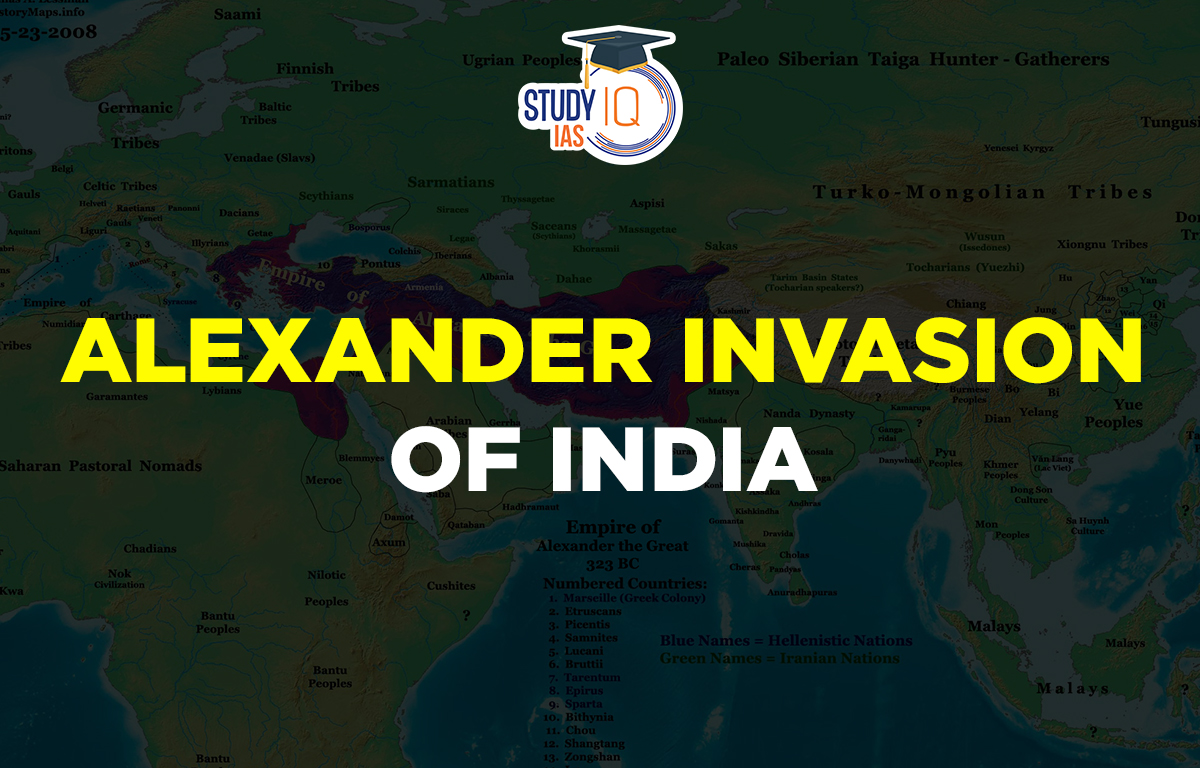Table of Contents
Alexander Invasion of India
Read all about Alexander Invasion of India. One of the great victors of antiquity is thought to have been Alexander, Philip of Macedonia’s son. He became king in 335 BC at the age of twenty. Alexander assembled a sizable army and started his conquests in 334 BC, driven by the desire to rule the entire globe. He actively engaged in waging war with Persia between 334 and 330 BC and captured Asia Minor, Syria, and Egypt after establishing his position by defeating nearby powers. This article has all the details about Alexander Invasion of India come under the Ancient History part of UPSC Syllabus.
Read about: Poligars Revolt
Alexander Invasion of India History
Alexander, the son of Philip of Macedonia, is considered to have been one of the great conquerors of history. At the age of twenty, he was crowned monarch in 335 BC. With a large army gathered and the desire to control the entire world as his motivation, Alexander set out on his expeditions in 334 BC. India’s grandeur captured Alexander’s attention. Before Alexander’s invasion of northwest India, there were additional minor kings there, such as Ambhi of Taxila and Porus of the Jhelum area (Hydaspes).
Ambhi acquiesced in Alexander’s authority, but Porus fought bravely but in vain. The Hydaspes War featured a duel between Alexander and Porus. Once Alexander’s troops arrived at the Chenab River, they occupied the kingdoms between Ravi and Chenab. However, his soldiers broke ranks and declined to cross the Beas River after that.
After years of battle, they were exhausted. In 326 BC, Alexander was forced to flee. Alexander visited Babylon in 323 BC. Following his passing in 321 BC, the Greek Kingdom fell. Four of Alexander’s generals were sent to various parts of northwest India. Eudamas was Alexander’s penultimate soldier in India.
Read about: Ramosi Uprising
Alexander Invasion of India Impact
Because Alexander Invasion of India was a relatively insignificant event in Indian history, it had little long-term influence on that society. Alexander’s invasion of India made it comparatively easy for Chandragupta to rule the numerous kingdoms and combative tribes of Punjab. It helped move Indian unity forward. By destroying the warlike tribes and small states, Alexander cleared the way for the establishment of a strong empire.
Alexander’s conquest opened up four new channels, which gave India a direct line of communication with the European countries. The discovery of these routes increased commerce as well. Alexander’s conquest influenced the course of Indian history. Modern Indian society has been widely covered in writings by Greek authors like Megasthenes and others. The Indians learned how to make magnificent statues and money from the Greeks. The Gandhara School of Art was greatly influenced by Greek sculpture. However, a number of Greeks turned to Hinduism, and the Indians had a big impact on philosophy.
Read about: Bhil Revolt
Alexander Invasion of India Effect
Alexander’s invasion gave rise to the first occasion when ancient Europe and ancient India came into direct contact. The establishment of direct contact between India and Greece in a number of fields was the invasion’s most important result. Four different land and sea routes were made possible thanks to Alexander’s effort. It paved the path for Greek craftsmen and traders.
The first time that ancient Europe and ancient India came into touch was as a result of Alexander’s invasion. The invasion’s most significant outcome was the beginning of direct interaction between Greece and India in several areas. Alexander’s efforts made it feasible for four distinct land and sea routes. It opened doors for Greek merchants and artisans.
Alexander’s scholars have thus left behind useful geographic records. They have also left clearly dated records of the campaign of Alexander, enabling Indian chronology to be built on a definite foundation for subsequent events. We learn valuable details about social and economic circumstances from Alexander’s scholars. They provide information on northwest India’s sati system and its beautiful breed of oxen.
His conquest opened the door for the Maurya Empire to grow there. Chandragupta Maurya watched Alexander’s army at work and learned some information that enabled him to defeat the Nandas, according to historians.
Read about: Khond Uprisings
Alexander Invasion of India UPSC
Alexander spent about two years in India. There have been a number of cultural interactions between Greece and India. In particular during the Maurya era, his invasion quickened the pace of governmental unification in northern India. Following his invasion, direct communication was made between India and Greece. Following the invasion, the northwest region of India was ruled by a number of Indo-Greek rulers. This made the influence of Greece on Indian art evident, particularly in the Gandhara School of Art.
Read all the details related to Alexander Invasion of India in this article for UPSC Exam Preparations. For more details related to any subject of UPSC Syllabus visit the office site of StudyIQ UPSC Online coaching.
Read about: Santhal Rebellion


 Nagari Pracharini Sabha Revival: Backgro...
Nagari Pracharini Sabha Revival: Backgro...
 Ryotwari System in India, Features, Impa...
Ryotwari System in India, Features, Impa...
 Battle of Plassey, History, Causes, Impa...
Battle of Plassey, History, Causes, Impa...





















